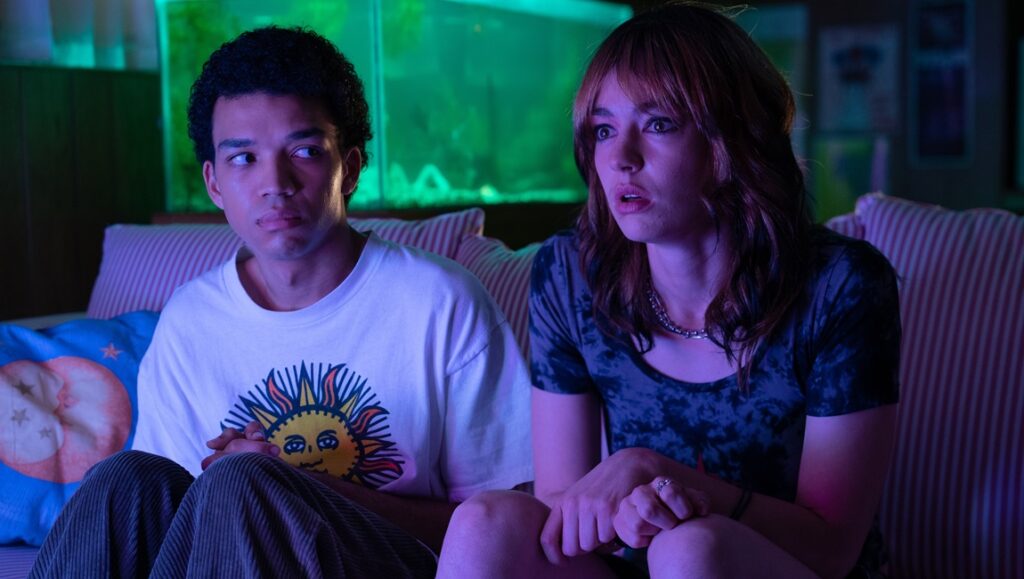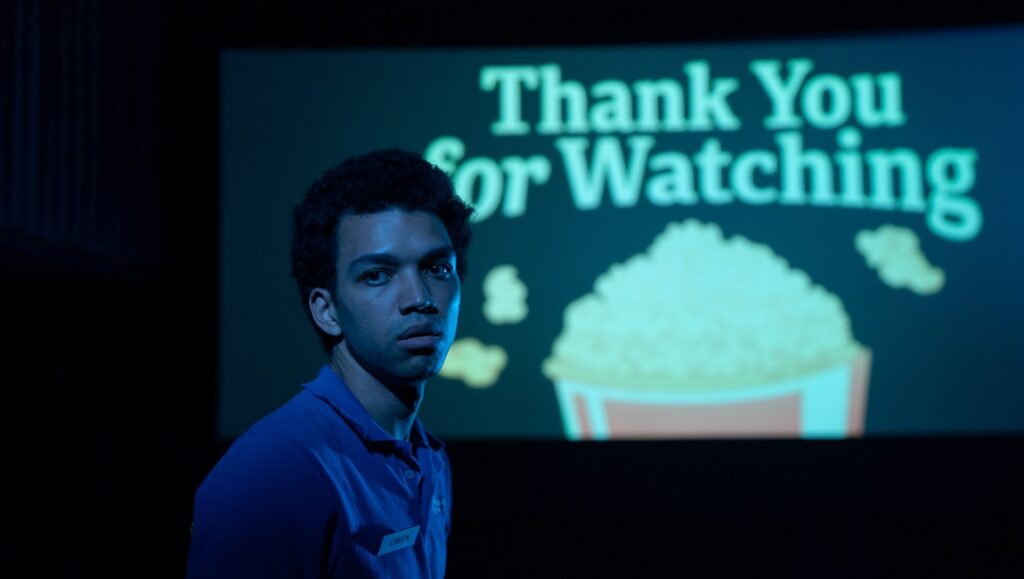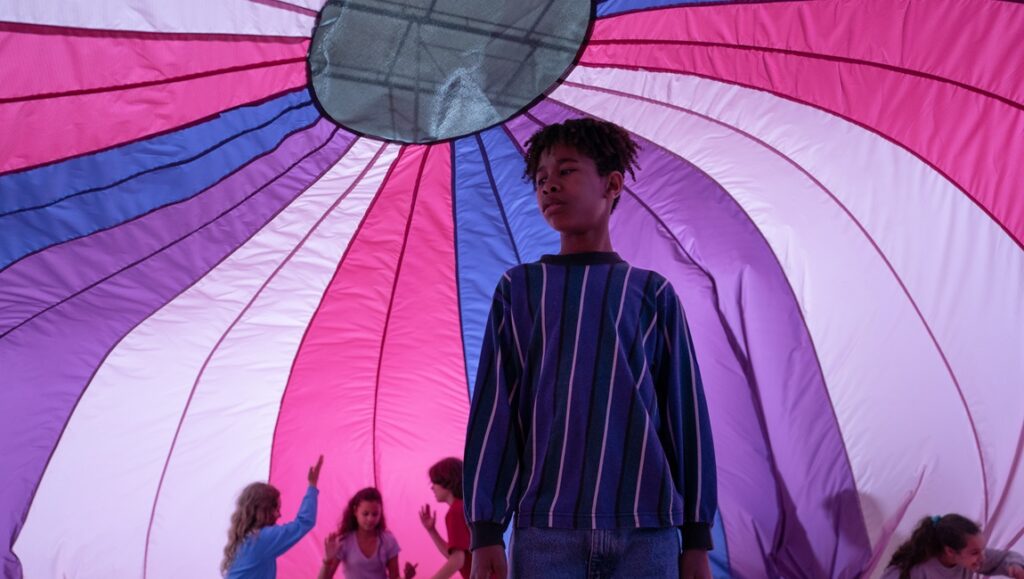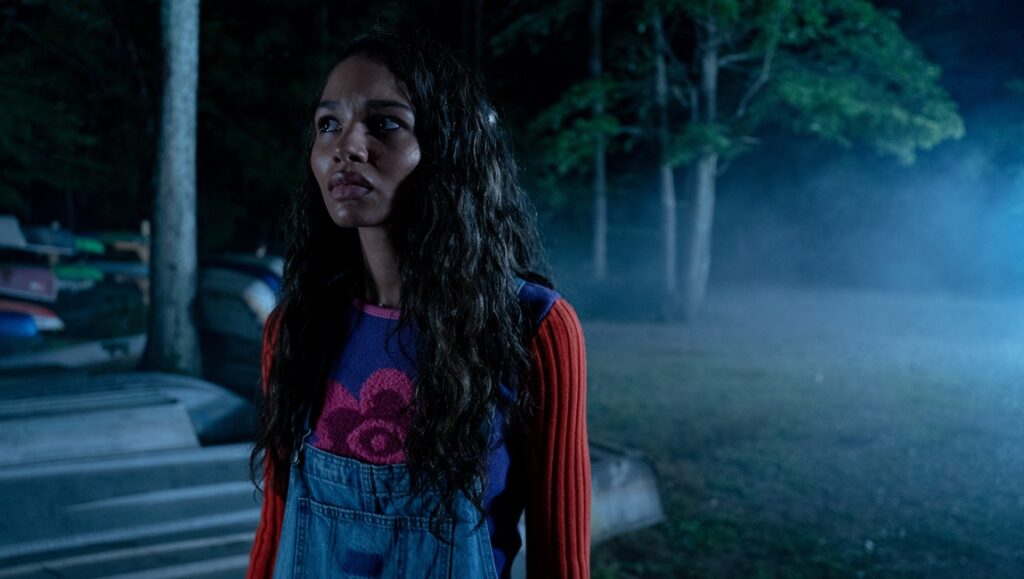s1e1 – “Pilot”
I have been thinking about Robin Wood and playing foxtail in a front yard that smelled like Sugar Maple leaves and garage concrete musk. Robin Wood was a film critic. He died in 2009. Foxtail was a game we used to play. One player lobbed the foxtail — a rubber ball with a long multicolored tail — as high as they could in the air. And then you had to catch it. The further down the tail, the smaller the colored segment, the more points you’d get. We didn’t keep track of points much, just liked the whistle it made falling through the air. We liked the way sometimes our hands would straddle a couple of colors. What was that worth?
When I was a child, I remember seeing the foxtail’s motion as distinctly at odds with the way the made-environment kept us constrained. Front yard, sidewalks, lots of houses, fences. To live in the suburbs is a study in bumping against boundaries and borders. But the foxtail sailed straight above those dividing lines. It whistled and wound, up and then down. If we missed it (and we often missed it), it would bounce a Baltimore chop off some straight edge.

s2e4 – “The I That Wasn’t There”
In the January/February 1978 issue of Film Comment, Robin Wood published “Responsibilities of a Gay Film Critic,” a kind of rough rupture for the writer. Wood’s writing post-1978 reflects a resharpened (though by no means exclusive) focus on Marxist and psychoanalytic readings, as well as a franker discussion of the possibilities and limitations of the gay liberation movement. “Responsibilities” serves as a kind of personal manifesto moment, and in it, Wood outlines two types of gay critic.
“First,” he writes, “the critic who for whatever reasons — many different ones are conceivable, of widely varying respectability — resists the public revelation of his gayness, arguing (either as defensive self-justification or as a sincerely held principle) that is has nothing to do with his view of art.” The “resistance” that Wood describes on the part of this theoretical critic doesn’t pertain only to that critic’s willingness to (publicly or privately) disclose or claim identification but also in what cultural objects they turn their attention to. It’s a resistance only too necessary in a publishing ecosystem that sees identity status as a forum of further commodification — how many gay critics are invoked especially (worse: solely) when a publication needs a reaction to All of Us Strangers (2023), an evisceration of Red, White & Royal Blue (2023)?
Wood goes on: “The other type of gay critic places the emphasis strongly, sometimes exclusively, on gay, and concerns himself strictly with works that have direct bearing on gayness, approaching them from a political-propagandist viewpoint: do they or do they not further the gay cause?” The examples (not incidental) that Wood cites see this second theoretical critic reviewing Fassbinder’s Fox and His Friends (1975) precisely because of its textual engagement with homosexuals and homosexuality, while forgoing Godard’s Tout va bien (1972), which possesses no obvious or observable (Wood’s word) “gayness.” This critical strategy only leads to the same crisis of cannibalized identity toward representation as a fungible, digestible entity — ignore Bergman and Hawks (the subjects of two studies by Wood), stick to your beat. And then? Liberation absorbed into incorporation. The closet replaced by a market. Motion and turbulence curtailed. Art as a sequence of permissions for sale.
The responsibility of the critic is to guard against uncritical forces, among them the branding of Public Relation and Self Promotion. What is the responsibility of the “I” in critical writing? Robin Wood writes: “I believe there will always be a close connection between critical theory, critical practice, and personal life, and it seems important that the critic should be aware of the personal bias that must inevitably affect his voice of theoretical position, and prepared to foreground it in his work.”

s3e13 – “I Remember Seeing”
Not toward pedantry, but nuance: the film is called ‘I Saw the TV Glow’, not ‘I Saw the TV’. The latter has to do with the matter inside a television: stories, characters, sensation, spectacle. The former has to do with the impressions we make from that matter: memory, desire, evocation, affect.
Films don’t have thesis sentences, they have centers of gravity. In this one, Jane Schoenbrun’s third feature, the moment occurs on the bleachers outside of a suburban high school (“Void High,” to the characters in the film, “Verona High School” to those whose NJ eyes can’t unsee our particular suburban zone.) Owen (Justice Smith) approaches Maddie (Brigette Lundy-Paine) to talk about their shared favorite television show, The Pink Opaque. Slumping a backpack against the metal, long sleeves dragged as far to the knuckles as they’ll stretch, Owen asks if Maddie wants to watch the show together again sometime, like that fated late-night watch two years ago, when Owen looked different (Ian Foreman plays the younger Owen) and Maddie offered a space to sit unapologetic in the glow. At Owen’s question, Maddie says “You know I like girls, right?” and Owen recoils, chokes back speech, shrinks and shrinks. Grinning just a little at the visible embarrassment and realizing there’s no threat, just sweetness, Maddie asks, “What about you, do you like girls?”
Schoenbrun and their actors place an iota between Maddie’s winking question and Owen’s side-stepped response. In a moment, there is a possibility for motion, flight, turbulence. There is still time and possibility for possibility and time. Sometimes all it takes is being asked, having a moment gifted to you. But Owen can’t. This is a film about a character who can’t. “I think… that I like TV shows,” says Owen.
“As any trans person might tell you,” Juan Barquin writes, “the ‘egg crack’ — when the shell of denial, about your gender, breaks open — is a pivotal moment, one that can’t be put back together again.” I Saw the TV Glow is about the pivotal moment denied, over and over again, in history and memory. As an adolescent, then through drudging young adulthood, and finally as a grown-up who wears trauma like movie special effects, Owen both sees how static suburbia silent-violently muffles actualization while simultaneously finding it impossible to actually put language to the anguish. And so The Pink Opaque and the glow it leaves become the beloved object, a transition of desire to a transmitted object that shows the space of relief but not the feeling.
Schoenbrun’s metaphor is explicit: denying the chance to change is living life buried alive. I Saw the TV Glow is a “psychological horror film” because it transfers that half-life feeling into its mise en scène and camera movement. The suburbs Owen languishes in are full of unhomely objects, and Schoenbrun shoots them all as charged, looming threats. A crop of shopping carts surveil through a sliding glass door. A downed power line snakes to life and regurgitates a half-familiar book. A father watches a television program, unsmiling even as the sound from the box is canned with uncanny laughter.
In his brilliant 2023 study written around the German director, Fassbinder Thousands of Mirrors, Ian Penman writes:
“We too easily speak a line like: ‘When I was a child, I remember seeing…’ Was there ever any real choice or subjective agency involved? Television is already a far more ambiguous thing, as place, than the cinema. The television screen in the domestic realm — a combination of the mother’s face and the father’s voice. Ambient stealth. All of sudden there something was, in fuzzed hypnotic, everyday light.”
The ambiguity that Penman refers to here, the way the image lives inside a box, instead of against a screen, the way it locks us up and liberates us, pharmakon-like, both with the twist of a fantasy, is treated in Schoenbrun’s film with a tender, tactile touch. The Pink Opaque becomes a dead-end fixation for Owen. It breaks Maddie open. To live in the suburbs for any stretch of time is to need objects like The Pink Opaque. You can’t live in the glow, but you can find your footing in its light. The film ends with a primal scream, endless apologies to no one, buried alive. And the film ends with actual flight, a new name, never looking back.
Except that’s not true, really: Maddie does look back, gives Owen another moment — what else could we be responsible for, except each other?

s4e8 – “The Night of Too Many Questions”
When the first trailer for I Saw the TV Glow began to show up in multiplexes around the country, its various pull-quotes and endorsements could be credited to precisely zero trans film critics. Righteous crankiness (most of it online) followed, of which I confess I partook. After 2021’s We’re All Going to the World’s Fair — “A film ostensibly about dysphoria and losing control of one’s body,” per Caden Mark Gardner, among others — as well as early reviews indicating just how forthright TV Glow was in its metaphoric fallout of acting on or ignoring trans identity, it seemed like the very least a studio hoping for good PR could do was cite a trans critic or two. Not that such a gesture would materially change anything, least of all the number of trans critics employed by stable publishing outlets or pursuing careers in moving image-making. Again: the least that could be done.
The eternal distraction of publishing critical writing in an ecosystem destabilized by capitalism is that everything’s for sale, identity and perspective included. There is, of course, adequate space to hold two thoughts: 1.) Trans writers should, if they want, have access to the kinds of outlets and opportunities that would enable them to honestly critique, for fair compensation, I Saw the TV Glow and 2.) No writer, regardless of how they do or don’t identify, should be responsible for having an opinion, let alone possessing a positive one. And film criticism has to mean more than getting pull quotes into ad copy.
More than its place revealing the same old media strategy of consuming personal identity and labor for marketable content, the consternation over TV’ Glow’s trailer is more galling for asserting exactly how movie studios, and their presence as purse string pullers, conceive of critical endorsements. A film review is a thing to be pilfered until its sentences seem ambivalently celebratory and until it indicates (removed from context) a given advertising narrative strategy. Schoenbrun’s film, in these terms, is a “one-of-a-kind masterpiece,” “original,” “evocative,” “adventurous,” “unforgettable,” and “for our era.” There are lovely and astute writers cited in the trailer’s cherry-picking praise, and the repurposing of their prose isn’t their fault, obviously. But in so much as language itself can seemingly always be reclaimed by capitalism, here is another moment ripe for the motion of Robin Wood’s pen:
“What are the responsibilities of a trans film critic in responding to the “trans film”? What are the responsibilities of a cis film critic in writing about transness in film? Where do we put our ‘I’ in writing, and how might the whole practice of thinking, caring, and writing critically about film preserve liberatory worlds without collapsing under ideological demands?”

s5e2 – “You Don’t Know Me”
As a rash of reviews will tell you, I Saw the TV Glow arrives in a moment alongside at least two (depending on the reviewer’s perspective) other high-profile “trans films” — the quotation marks belay the beleaguering effect of lumping these disparate films together for reasons of identification. Expressing affection for Theda Hammel’s Stress Positions (2023) as well as Vera Drew’s The People’s Joker (2023), Schoenbrun was matter-of-fact in conversation with Ari Lisner: “…three films by three while trans girls does not a trend make.”
The frustration is the same as when any group of disparate, different cultural objects can only be understood societally as bound by the identities of their makers. See: “New Queer Cinema” as a way of knowing objects as variable in mood and mode as Derek Jarman’s Edward II (1991), Todd Haynes’s Poison (1991), and Gregg Araki’s The Living End (1992). The problem with understanding art through identity markers is twofold. First, it subsumes the work of art in the world to that which merely affirms an individual identity, and so, that which can be bought and sold more efficiently. Then also, this subsuming into identity categories — trans, queer, black, “foreign,” and so on — assumes that the theoretically pure critical position from which these designations receive naming is of a white cisgender heterosexuality. To identify Hammel’s film as one member of “2024’s trans films” means it can’t be the screwball situational that it is, that it also can’t be the first genuinely incisive filmic look at the self-surveillance too many of us did and do in our communities, through COVID, before it, after it.
But then, of course, there is something trans in Stress Positions, in all three of these films. But some element of framing them as “trans films” betrays a cis lens — this is the only language for reading these films. And so? What are the stakes of indulging in the unexamined cis lens? (Or: what are the responsibilities of the cis film critic?
In the same conversation with Lisner, Schoenbrun begins their analysis of our tendency to identify “2024’s trans moment in film” without equivocation: “There is something special about how trans people see the world.” I’m reminded of the way Torrey Peters talks about a trans lens on living. In conversation with Sam Sanders, Peters says, “I think cis people are beginning to understand the way that gender works, and their own gender, through ideas that come from a trans lens.”
I’m reminded of the way Peters — who Schoenbrun cites in radio interviews — talks about the relationship between divorced cis women and trans people looking for role models, at the overlaps and divergences in these perspectives. Peters talks about looking for meaning after changing her life, after transitioning. She finds in the writing of divorced cis women “models for me on how to live because what I was finding in them was that they had experienced a break in life, a moment of changing in which they had to reassess themselves and they had to be honest about who they were and what they wanted. And then they had to make a plan going forward.”
In returning to that conversation with Sanders, I’m struck by how my memory warps. “Trans lens” comes up, but only once from Peters herself. The other six usages of the phrase are from Sanders. Certainly, there is something cis people can learn from trans people; we live in a community. We share our strategies and designs for living, especially abandoned and antagonized as we are by every authority in America, under capitalism, against despair. But there is a thin sharp line between learning a lesson from a person whose perspective is different from yours and turning their life into a metaphor to be stripmined for your own meaning.
On the one hand, there’s the desire to see I Saw the TV Glow as a true triumph of trans filmmaking, textually composed to be about the stakes of transition, about the oppression of living in spaces that don’t see you as you see yourself; on the other, the desire to let the film be the so much more that it already is, to not subject it to the weight of representation — to let it be the image and the afterglow.

s6e18 – “End of Speech is the End of the Day”
One of the great accomplishments of Schoenbrun’s film is that it’s not subversive. The modern critic has a torturous relationship to “subversive,” especially post-Barbie (2023). But I Saw the TV Glow is a kind of glorious con; I watched the film in the same suburban multiplex I first worked at when I was 14. It would have saved lives then, just as I suspect it might now. I don’t think that’s an undue burden to place on the film. You can save someone’s life simply by giving them a question and a moment and not asking them to apologize. An under-discussed facet of the film is its use of direct address: Owen relays large swaths of the story direct-to-camera, to us. The effect is the creation of an enclosed space — under a parachute, in a temporary gym planetarium — where other things might be said.
The effect of the narration is similar in style and mood to that of Big Pete’s narration in The Adventures of Pete and Pete. That show, like much of TV Glow, was shot in and around the NJ suburbs. It details a recognizably suburban ennui, unfolding its long afternoon stories as sites of both endless possibility and also deep, uncertain yearning. It’s a show about outsiders living outside something. And in placing the language of narration in Big Pete’s mouth and much of the free-mobility action in Little Pete’s half-known motivations, like Schoenbrun’s film, the show presents a stunted, central figure who scrutinizes from a distance another seemingly-more-free entity.
Big Pete (Michael Maronna) and Little Pete (Danny Tamberelli) appear in I Saw the TV Glow: Owen opens the door, and there they are: stunned, flanging, older, unhomely. There’s no reason to think this moment is meta or winking — these are the same streets and lawns, that’s Big Pete and Little Pete now. This is what it’s like to stay where you are, especially when where you are is this. Rather than thinking about a trans lens that I Saw the TV Glow could theoretically gift to its cis viewers, the film’s inclusion of these characters seems like a ledge for a “cis reading” of Schoenbrun’s film. Not because that audience needs to see characters it can identify with, but because it admits how the abject feeling emerging from the American suburb — unmoored loneliness, a sense of surveillance curtailing any activity deemed deviant, a tragic straightness — inspires despair equally in all people.
The word “trans” is never spoken in I Saw the TV Glow. It’s another coup from the film; you could live a life in the spaces and times depicted in Schoenbrun’s film and never hear the word. As textual and forthright as the film is for a certain audience, it inspires in another a whole other set of language: Buffy, analog, nostalgia, suburbs, horror. This language addresses things and themes that pervade the film, that aren’t used by Schoenbrun as figurative stand-ins, but rather are exposed in the corona coming off the matter of the screen. The trick, and the thing to be truly gracious to Schoenbrun and their collaborators for, is that all these entities and feelings occupy the same frame. Here is the great trans film, as like all the ones before it and the ones not made yet. Here is the great suburbs film. Here is the nostalgia and the ache and the warning away from these fonts.
The lodestar image in a film packed with invention is Owen walking, the camera tracing the motion in a lateral tracking shot. The shot occurs multiple times throughout the film, in different directions. It shows Owen moving across the arbitrary dividing lines of this designed world. Over the borders of lawns, off the straightened sidewalks. It’s one of the few real occasions where Owen moves unapologetically and without regard for the rigidities of this world. It is heartening and sad.
In conversation with the filmmaker Prashant Kadam, as part of a proposed and as-yet-made documentary, Robin Wood reflects on criticism and film studies. What he wants — for himself and his students, he says — is “to ask ourselves, where does this film take me? From the beginning to the end… It’s the intimate journey between the individual and the film that interests me.” This may be the only responsibility films have to us, that we have to films. Seconds later, Wood talks about how he feels like this approach, his approach — of clarity and intimacy, of feeling and imperfect identification and rigor and affection — seems to be coming back around, critically, academically, in prose and life. Cracking a little, he says, “I feel a little more as if I have a place in the world.”


Comments are closed.